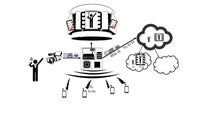Background
Ever increasing wireless connectivity, computational power, cloud storage, connected sensors and a breadth of user engaging Apps have enabled smartphones to play a role in almost all our daily activities. With this shift to mobile connectivity, companies are highly motivated to engage their customers through targeted mobile advertisements, loyalty programs and coupon distribution. The challenge however is that pushing advertisement to customers is often viewed as a nuisance or worse as an invasion of their privacy leading to negative brand sentiment. Ideally companies would prefer mobile marketing platforms that are driven by customers proactively seeking out content that provides a valuable user experience to them.
Description of the invention
The University of Waterloo has developed a wireless mobile platform that enables users to request location based multimedia content driven by sensory stimulus motivation. For instance a sensory stimulus such as visual observation of digital signage or scents arising from fragrances (e.g. perfumes) may motivate consumers to reactively actuate their smartphones Apps to access information regarding the provided sensory content or have it sent to their cloud accounts for later reference and use.
Advantages
The invention engages customers in a way that drives them to seek out information about pleasant sensory experiences they are exposed to. This enables companies to provide advertisements, coupons, and in-App purchasing opportunities in a brand friendly user “pull” manner.
Potential applications
One application currently prototyped targets live entertainment experiences (eg. concert) to offer event attendees a solution to taking smartphone photos that otherwise suffer from on-board technology limitations that often lead to grainy and poor-quality photos (under typically poor lighting situations). Typically fans are passionate in their support of the artist and many desire to have memorable photo keepsakes from such a sensory experience (ie. photo performing fan’s favourite song). The Waterloo system utilizes a combination of smartphone App software with novel device hardware connected to live event display screens (ie. stadium jumbotron) that enables event attendees to capture photos or short video clips from the live feeds displayed on the venue display screens. This enables attendees to develop a personalized package of high-resolution pictures and/or video clips that can be directly downloaded to their smartphones or stored on their cloud storage account. This “user” pull application enables marketing sponsorship opportunities to provide companion advertising, couponing, and in-App purchases as part of this user engagement experience. This service will also likely appeal to the artists who are very conscious of their “image” and this enables them to manage their visual images by offering fans pictures from desired angles, postures, and highlight moments. It also provides them a revenue sharing opportunity for in-App purchases (eg. photos, other artist products, such as t-shirts, etc.). Other applications include: live sports events, convocations, and location linked product advertising and sales.

A specific embodiment of Multimedia Content Enabling System
Reference
8810-7400
Inventor
Pin-Han Ho
Patent status
US Patents Issued:
US 10, 142, 375
US 10, 778, 727
Stage of development
Prototype Built
Contact
Scott Inwood
Director of Commercialization
Waterloo Commercialization Office
519-888-4567, ext. 33728
sinwood@uwaterloo.ca
uwaterloo.ca/research